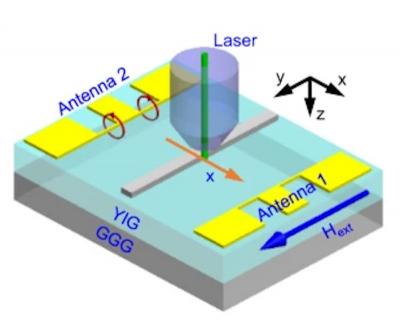Researchers at Aalto University have developed a new device for spintronics, which could be seen as a step towards using spintronics to make computer chips and devices for data processing and communication technology.
 Schematic of the experimental geometry. Image from article
Schematic of the experimental geometry. Image from article
"If you use spin waves, it's transfer of spin, you don't move charge, so you don't create heating," says Professor Sebastiaan van Dijken, who leads the group that wrote the paper. The device the team made is a Fabry-Pérot resonator, a well-known tool in optics for creating beams of light with a tightly controlled wavelength. The spin-wave version made by the researchers in this work allows them to control and filter waves of spin in devices that are only a few hundreds of nanometres across.
The issues with speeding up electronics goes beyond overheating; there are also complications in wireless transmission, as wireless signals need to be converted from their higher frequencies down to frequencies that electronic circuits can manage. This conversion slows the process down and requires energy. Spin wave chips are able to operate at the microwave frequencies used in mobile phone and WiFi signals, which means that there is a lot of potential for them to be used in even faster and more reliable wireless communication technologies in the future.
Furthermore, spin waves can be used to do computing in ways that are faster that electronic computing at specific tasks "Electronic computing uses "Boolean' or binary logic to do calculations," explains Professor van Dijken. "With spin waves, the information is carried in the amplitude of the wave, which allows for more analog-style computing. This means that it could be very useful for specific tasks like image processing or pattern recognition. The great thing about our system is that the size structure of it means that it should be easy to integrate into existing technology."
Now that the team has the resonator to filter and control the spin waves, the next steps are to make a complete circuit for them. "To build a magnetic circuit, we need to be able to guide the spin waves towards functional components, like the way conducting electrical channels do on electronic microchips. We are looking at making similar structures to steer spin waves," explains Dr. Qin.